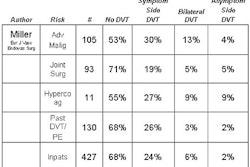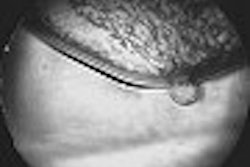Even before symptoms occur, the hearts of diabetics undergo changes -- abnormalities that can be detected with non-invasive tissue Doppler tests, researchers reported at the 2003 International Diabetes Federation Congress in Paris.
"If we can find evidence of heart abnormalities earlier, we may be able to treat these patients earlier as well," said Dr. Inga Thrainsdottir, a specialist in internal medicine and cardiology at Karolinska Hospital in Stockholm.
Seventy-seven subjects (average age, 61) were enrolled, of which 43 had Type 2 diabetes mellitus. About two-thirds were men and had a left ventricular ejection fraction of 57%. They were compared with 34 non-diabetics (average age 58), about 62% of whom were men. These controls also had an ejection fraction of 57%, indicating a normal heart function.
The patients then underwent in-office tissue Doppler imaging. The ultrasound test recorded myocardial regional velocities from six areas of the heart while the patients were at rest or undergoing heart stress examinations.
According to the results, there were significant differences in systolic, early diastolic and late diastolic velocities of the patients who already had documented diabetes. The patients with diabetes had a higher systolic blood pressure and pulse pressure at rest, and when undergoing dipyridamole stress, the authors wrote in their poster presentation.
"One of the advantages of doing tissue Doppler imaging is that you can record the tests and then analyze them later off-line," Thrainsdottir said. "Diastolic and systolic myocardial dysfunction was identified by quantitative tissue Doppler imaging before the onset of clinical signs of heart failure and appearance of traditional echocardiographic indices of dysfunction."
In a commentary, Dr. Eva Toft said studies such as these highlight the far-reaching effects of Type 2 diabetes, including the possibility that these patients may have serious, undiagnosed cardiac damage. Toft is with Ersta Hospital in Stockholm.
However, Dr. Derek Stocker countered with a caveat for the study: diabetic cardiac problems may not warrant a change in treatment protocol.
"We don't know from this study if the dysfunction that is being seen is important enough to treat people differently than we do now -- with anti-diabetes medicine, cholesterol lowering agents and blood pressure lowering drug," said Stocker, who is an assistant professor of medicine at the Uniformed Services University of Health Sciences in Bethesda, MD.
He added that placing these patients on medication could be premature, as anti-arrhythmia drugs often have uncomfortable side effects.
In her report, Thrainsdottir also suggested that tissue Doppler imaging could be useful in pharmacological studies aimed at preventing diabetic cardiomyopathy. Using ultrasound to check on the hearts of patients with early glucose resistance may offer clues as to how soon abnormalities begin in the progression from insulin resistance to frank diabetes.
Prospective studies would need to be carried out with Doppler imaging to assess its true value in these patients with diabetes, said Dr. Amanda Adler, a clinician and epidemiologist at Oxford University in Oxford, UK.
"We would like to see this type of study carried forward prospectively to determine if these early abnormalities have clinical significance later on," she said, adding that cost of imaging exams would also have to be explored. Certain blood tests currently used to assess glucose levels could be as predictive as imaging, but less expensive, Adler said.
By Edward SusmanAuntMinnie.com contributing writer
September 24, 2003
Subtle LV dysfunction seen with early diabetic heart disease, August 13, 2003
Dobutamine stress echo aids prediction of CAD events and death in diabetics, April 9, 2003
Calcified plaque increased in coronary arteries of diabetics March 20, 2003
SPECT MPI predicts cardiac danger in diabetics January 14, 2002
Copyright © 2003 AuntMinnie.com



















